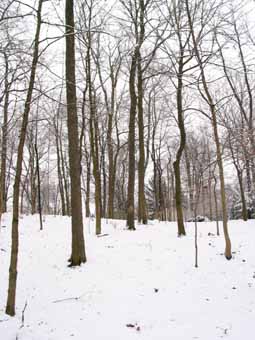 | January 5: We had snow at Christmas, which soon melted, then another little snowfall of about three inches after New Year's. This shows the woods from the bottom of the hill, looking up the path. All of the features on the ground are buried under the snow, but when I took a walk through the woods on January 1, I found that the groundcovers looked in good shape and the deer don't seem to be interested in us yet. |
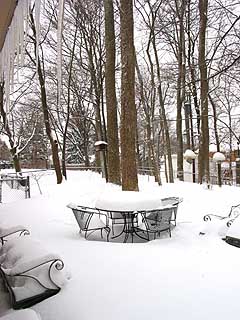 |
February 17: After a slight thaw early in February, we got slammed with heavy snow over a couple of days. By this morning we had around twelve inches on the ground. You can see the build-up on the patio table. Some of the icicles on the roof (at the left) are almost three-feet long. The squirrels have burrowed under the snow to find the sunflower seed I scattered throughout the storm and they are diving into the snow, then popping up to eat the seeds. They look like little jack-in-the-boxes! |
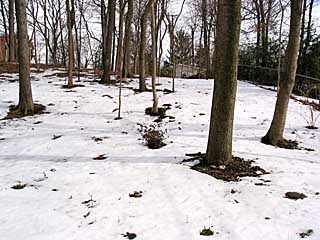 |
March 8: This slope faces west, so doesn't get direct sun in winter. Snow is melting at the bases of trees. Yesterday morning I walked up the path through snow still several inches deep. So far nothing has poked up through the earth. Last year I recorded wildflower at the arboretum on February 17, but they froze to death a few days later. I think they'll be safe this year. |
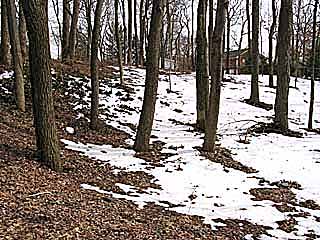 |
March 8: The weather has been a roller-coaster, but mostly downhill, for the past two weeks. We topped out at about fifteen inches of snow for the period, not much for some places, but enough to snarl traffic and cause school closings. A couple of nights ago it went down to 7 degrees Farenheit, then bounced back to just above freezing under sunny skies. The snow on the south-facing slope at left has melted away. |
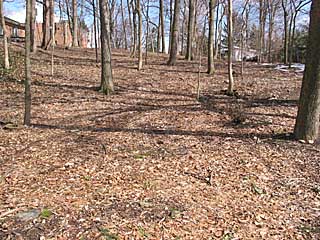 |
March 9: Look! No snow! After temperatures above 50 degrees yesterday afternoon, the snow has all but vanished on this same slope. The winter started late for us this year, and hit us hard, but it looks like the worst is over. The sun is glorious today and I found evidence of several plants pushing up through the dead leaves. |
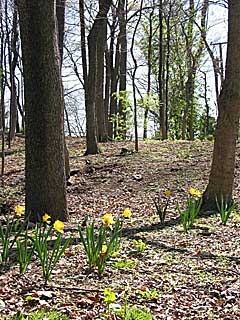 |
April 11: Spring is finally coming to the woods. The daffodils are in their glory. Up on the hill, Winter Aconite and Snowdrops are blooming and around the edges are other naturalized bulbs, like Grape Hyacinth, Grecian Windflower and Dwarf Yellow Iris. You can see them on the Wildflowers pages. The green trees on the hillside and in the background are Ohio Buckeyes. On the forest floor are a number of Buckeye seedlings and the ground is covered with Large-leaved Waterleaf. The Virginia Bluebells are about to bloom, Toadshade Trillium is already blooming. The Bluebells are well established, but many of my other plants are new and still small--but they're coming up, just the same.
|
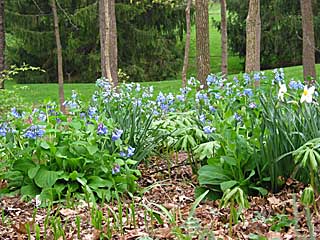 |
April 18 Soon the Virginia Bluebells began to bloom, covering the crest of the hill near the patio. The May-apples are pushing up just in front of the bluebells. Behind the bluebells on the hillside down to the lower woods is a lovely stand of Toothwort.
|
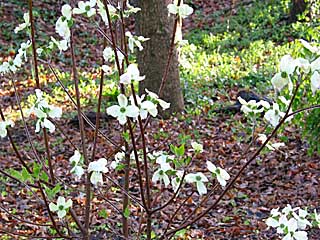 |
April 23 Our lawn sprinkler system was re-set last year to include the lower edge of the woods. This year it was turned on and set for a trial run when the temperature plunged to below freezing. The water on this dogwood tree froze and protected the flowers from ruin. |
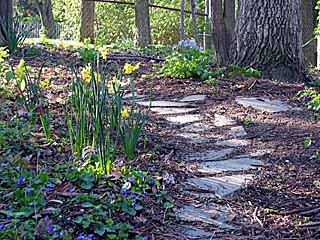 |
April 30 Daffodils and blue violets bloom next to the path into the woods. At the top of the picture is a cluster of Wild Blue Phlox that I hope will spread. We used to have a lot of phlox growing wild throughout the woods. Near the phlox is a clump of Isopyrum, which has already spread to many places from the original plant I put in several years ago.
|
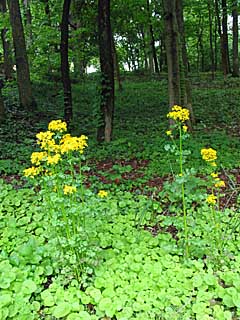 |
May 18 The lower edge of the woods appears to attract Butterweed. They were so bright and cheerful I let them bloom but didn't let them go to seed. The Garlic-mustard on the forest floor is thick and has to be hand-pulled before they set seeds. They are almost as big a pest as the honeysuckle.
|
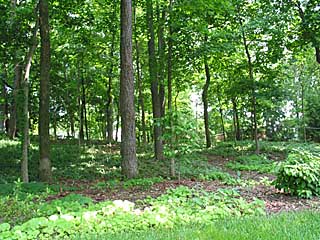 |
May 25 We've had an unusually rainy May, which makes the woods beautifully green and lush. The new shrubs and trees--viburnum, hydrangea, dogwood and redbud are loving it. I lost four from last summer's drought, but their replacements are thriving so far. I also planted some Spice Bush and Sweet Shrub and a couple of Tulip trees that have leafed out nicely.
|
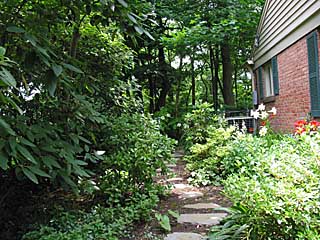 |
June 30 This little shade garden is my tryout spot for plants I'm unfamiliar with or unsure about how to handle in the woods. I can keep an eye on them here, where they are watered by a sprinkler system that once watered grass. This spot used to be sunny and I grew more than thirty roses in a special bed, but the trees and shrubs grew up and shaded it too much. I planted rhododendron, mountain laurel and azaleas and started this shady space at the edge of the woods.
|
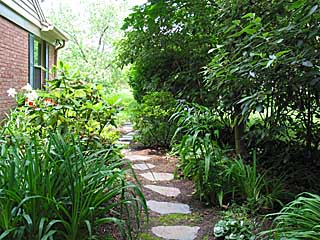 |
June 30 This is another view of the shade garden from the other direction. To the immediate right are wildflowers: Jack-in-the-pulpit, Twinleaf, Toadshade, White Trillium, Spring Beauty, Spiderwort and other plants that have been partially transplanted successfully in the woods. There are also a few perennials like daylilies, hosta and Siberian Iris.
|
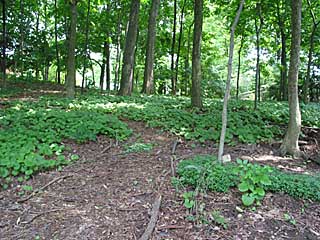 |
July 1 I removed the flowering garlic-mustard plants before they could set seeds. There weren't many because I cleaned out all the seedlings last summer and fall. Now I'm doing the same thing with the seedlings that would flower next year. This highly invasive plant blooms every two years. Here you can see a partially cleared area. Most of the green on the forest floor is garlic-mustard waiting to be pulled up by the roots and destroyed. The woods is still full of the stuff.
|
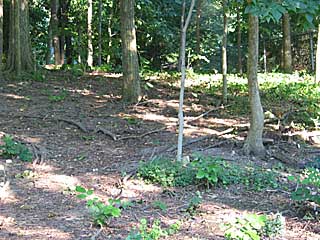 |
August 23 Throughout July and August I found Alum-root, Motherwort and Moth-mullein blooming in the woods. Eventually, Tall Bellflower, Ohio Spiderwort and Cardinal-flower bloomed gloriously. Rain came as afternoon and evening thundershowers, so my plants had sufficient water. Unfortunately, the garlic-mustard also grew lustily, so I have been digging out 6-to-8-inch roots, hoping to prevent them from sprouting and blooming next spring. This view shows the new path to the right that I've set to go through the back of the woods.
|
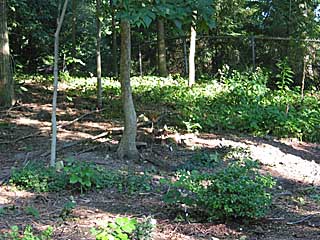 |
August 23 The entire lower edge of the woods was blanketed in garlic-mustard. Now all that remains starts about half-way up the hill next to the fence and ends at the top property line. It doesn't sound like much, but as you can see, it is quite a heavy cover. The ground is getting dry now, so making it harder to dig without breaking the roots. I have to water a bit to soften the earth before digging. There are an azalea plant and some other wildflowers in the foreground.
|
| Wildflowers | Home Return to Top |
| email:Nita Leland | © 1998-2012 Nita Leland All Rights Reserved. | Webmaster:Amy Elieff Brown |